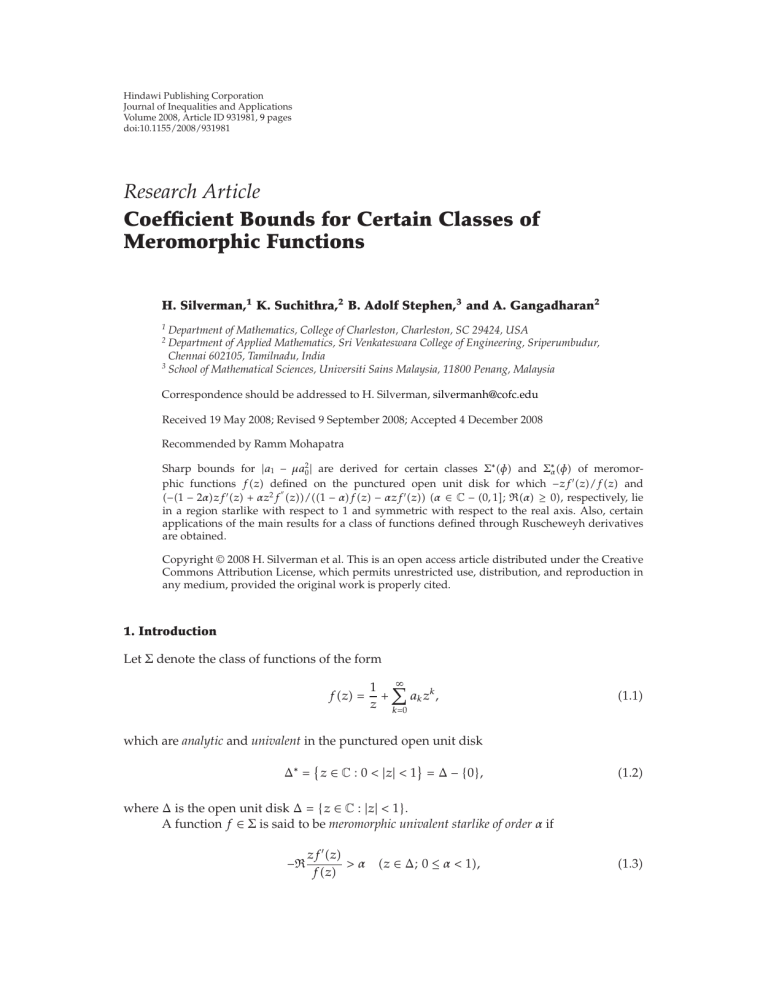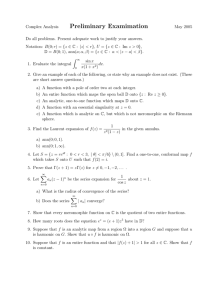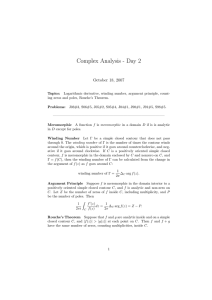Hindawi Publishing Corporation Journal of Inequalities and Applications
advertisement

Hindawi Publishing Corporation
Journal of Inequalities and Applications
Volume 2008, Article ID 931981, 9 pages
doi:10.1155/2008/931981
Research Article
Coefficient Bounds for Certain Classes of
Meromorphic Functions
H. Silverman,1 K. Suchithra,2 B. Adolf Stephen,3 and A. Gangadharan2
1
Department of Mathematics, College of Charleston, Charleston, SC 29424, USA
Department of Applied Mathematics, Sri Venkateswara College of Engineering, Sriperumbudur,
Chennai 602105, Tamilnadu, India
3
School of Mathematical Sciences, Universiti Sains Malaysia, 11800 Penang, Malaysia
2
Correspondence should be addressed to H. Silverman, silvermanh@cofc.edu
Received 19 May 2008; Revised 9 September 2008; Accepted 4 December 2008
Recommended by Ramm Mohapatra
Sharp bounds for |a1 − μa20 | are derived for certain classes Σ∗ φ and Σ∗α φ of meromorphic functions fz defined on the punctured open unit disk for which −zf z/fz and
−1 − 2αzf z αz2 f z/1 − αfz − αzf z α ∈ C − 0, 1; Rα ≥ 0, respectively, lie
in a region starlike with respect to 1 and symmetric with respect to the real axis. Also, certain
applications of the main results for a class of functions defined through Ruscheweyh derivatives
are obtained.
Copyright q 2008 H. Silverman et al. This is an open access article distributed under the Creative
Commons Attribution License, which permits unrestricted use, distribution, and reproduction in
any medium, provided the original work is properly cited.
1. Introduction
Let Σ denote the class of functions of the form
fz ∞
1 ak zk ,
z k0
1.1
which are analytic and univalent in the punctured open unit disk
Δ∗ z ∈ C : 0 < |z| < 1 Δ − {0},
1.2
where Δ is the open unit disk Δ {z ∈ C : |z| < 1}.
A function f ∈ Σ is said to be meromorphic univalent starlike of order α if
−R
zf z
> α z ∈ Δ; 0 ≤ α < 1,
fz
1.3
2
Journal of Inequalities and Applications
and the class of all such meromorphic univalent starlike functions in Δ∗ is denoted by
Σ∗ α.
Recently, Uralegaddi and Desai 1 studied the class Σα, β of functions f ∈ Σ
satisfying the condition
zf z/fz 1 ≤β
zf z/fz 2α − 1 z ∈ Δ; 0 ≤ α < 1; 0 < β ≤ 1.
1.4
Kulkarni and Joshi 2 studied the class Σα, β, γ of functions f ∈ Σ satisfying the condition
zf z/fz 1
≤ β
2γ zf z/fz α − zf z/fz 1 z ∈ Δ; 0 ≤ α < 1; 0 < β ≤ 1;
1
<γ ≤1 .
2
1.5
Earlier, several authors 3–6 have studied similar subclasses of Σ∗ α.
k
Let S consist of functions fz z ∞
k2 ak z which are analytic and univalent in
Δ. Many researchers including 7–11 have obtained Fekete-Szegö inequality for analytic
functions f ∈ S.
In this paper, we obtain Fekete-Szegö-like inequalities for new classes of meromorphic
functions, which are defined in what follows. Also, we give applications of our results to
certain functions defined through Ruscheweyh derivatives.
Definition 1.1. Let φz be an analytic function with positive real part on Δ with φ0 1,
φ 0 > 0, which maps the unit disk Δ onto a region starlike with respect to 1, and is symmetric
with respect to the real axis. Let Σ∗ φ be the class of functions f ∈ Σ for which
−
zf z
≺ φz
fz
z ∈ Δ,
1.6
where ≺ denotes subordination between analytic functions.
The above-defined class Σ∗ φ is the meromorphic analogue of the class S∗ φ,
introduced and studied by Ma and Minda 8, which consists of functions f ∈ S for which
zf z/fz ≺ φz, z ∈ Δ.
More generally, under the same conditions as Definition 1.1, we add a parameter.
Definition 1.2. Let Σ∗α φ be the class of functions f ∈ Σ for which
−1 − 2αzf z αz2 f z
≺ φz
1 − αfz − αzf z
z ∈ Δ; α ∈ C − 0, 1; Rα ≥ 0 .
1.7
H. Silverman et al.
3
Some of the interesting subclasses of Σ∗α φ are
1 Σ∗0 φ Σ∗ φ,
2 Σ∗0 1 1 − 2αz/1 − z Σ∗ α, 0 ≤ α < 1,
3 Σ∗0 1 β1 − 2αγz/1 β1 − 2γz Σα, β, γ, 0 ≤ α < 1, 0 < β ≤ 1, 1/2 ≤ γ ≤ 1
studied by Kulkarni and Joshi 2,
4 Σ∗0 1 Awz/1 Bwz K1 A, B, 0 ≤ B < 1; − B < A < B studied by
Karunakaran 12.
To prove our result, we need the following lemma.
Lemma 1.3 see 13. If pz 1 c1 z c2 z2 c3 z3 · · · is a function with positive real part in
Δ, then for any complex number μ,
c2 − μc2 ≤ 2 max 1, |1 − 2μ| .
1.8
1
2. Coefficient bounds
By making use of Lemma 1.3, we prove the following bounds for the classes Σ∗ φ and Σ∗α φ.
Theorem 2.1. Let φz 1 B1 z B2 z2 · · · . If fz given by 1.1 belongs to Σ∗ φ, then for any
complex number μ,
B2
B1 2
max 1, i a1 − μa0 ≤
− 1 − 2μB1 ,
2
B1
ii a1 − μa20 ≤ 1, B1 0.
B1 /
0,
2.1
2.2
The bounds are sharp.
Proof. If fz ∈ Σ∗ φ, then there is a Schwarz function wz, analytic in Δ with w0 0 and
|wz| < 1 in Δ such that
−
zf z
φ wz .
fz
2.3
Define the function pz by
pz 1 wz
1 c1 z c2 z2 · · · .
1 − wz
2.4
4
Journal of Inequalities and Applications
Since wz is a Schwarz function, we see that Rpz > 0 and p0 1. Therefore,
φ wz φ
pz − 1
pz 1
φ
1
c1 z 2
1
1 B1 c 1 z 2
c2
c2 − 1
2
z 2
1
1
B1 c2 − c12
2
2
c13
3
− c1 c2 z · · ·
c3 4
2.5
1
B2 c12 z2 · · · .
4
Now by substituting 2.5 in 2.3, we have
−
zf z
1
1 B1 c 1 z fz
2
1
1
B1 c2 − c12
2
2
1
B2 c12 z2 · · · .
4
2.6
From this equation and 1.1, we obtain
a0 B1 c 1
0,
2
a0 B1 c1 B1 c2 B1 c12 B2 c12
−a1 a1 −
.
2
2
4
4
2.7
Or equivalently,
1
a0 − B1 c1 ,
2
1 1
1
2 2
B1 c 2 B 2 − B1 − B1 c 1 .
a1 −
2 2
4
2.8
Therefore,
a1 − μa20 −
B1 c2 − vc12 ,
4
2.9
where
v
B2
1
1−
1 − 2μB1 .
2
B1
2.10
Now, the result 2.1 follows by an application of Lemma 1.3. Also, if B1 0, then
a0 0 and a1 −1/8B2 c12 .
Since pz has positive real part, |c1 | ≤ 2, so that |a1 − μa20 | ≤ |B2 |/2. Since φz also has
positive real part, |B2 | ≤ 2. Thus, |a1 − μa20 | ≤ 1, proving 2.2.
H. Silverman et al.
5
The bounds are sharp for the functions F1 z and F2 z defined by
−
zF1 z
φ z2 ,
F1 z
zF z
φz,
− 2
F2 z
1 z2
where F1 z ,
z 1 − z2
2.11
1z
where F2 z .
z1 − z
Clearly, the functions F1 z, F2 z ∈ Σ.
Proceeding similarly, we now obtain the bounds for the class Σ∗α φ.
Theorem 2.2. Let φz 1 B1 z B2 z2 · · · . If fz given by 1.1 belongs to Σ∗α φ, then for any
complex number μ,
i
B1
max 1, B2 −
B
21 − 2α
1
1
a1 − μa2 ≤ 0
1 − 2α , B1 0.
a1 − μa2 ≤ 0
ii
1−
21 − 2α
1 − α2
μ B1 ,
B1 / 0,
2.12
2.13
The bounds obtained are sharp.
Proof. If fz ∈ Σ∗α φ, then there is a Schwarz function wz, analytic in Δ with w0 0 and
|wz| < 1 in Δ such that
−1 − 2αzf z αz2 f z
φ wz ,
1 − αfz − αzf z
α ∈ C − 0, 1, Rα ≥ 0 .
2.14
Now using 2.5 and 1.1 in 2.14, and comparing the coefficients, we have
1
a0 1 − α B1 c1 0,
2
1
1
1
−a1 1 − 2α a1 1 − 2α a0 1 − αB1 c1 B1 c2 − B1 − B2 c12 ;
2
2
4
2.15
or equivalently,
1
B1 c 1 ,
21 − α
1
1
1
a1 −
B1 c2 B2 − B1 − B12 c12 .
21 − 2α 2
4
a0 −
2.16
Therefore,
a1 − μa20 −
B1
c2 − vc12 ,
41 − 2α
2.17
6
Journal of Inequalities and Applications
where
B2
1
1−
v
2
B1
1−
21 − 2α
1 − α2
μ B1 .
2.18
Now, the result 2.12 follows by an application of Lemma 1.3. Also, if B1 0, then a0 0 and
a1 −1/81 − 2αB2 c12 .
Since pz has positive real part, |c1 | ≤ 2, so that |a1 − μa20 | ≤ |B2 |/21 − 2α. Since φz
also has positive real part, |B2 | ≤ 2. Thus, |a1 − μa20 | ≤ |1/1 − 2α|, proving 2.13.
The bounds are sharp for the functions F1 z and F2 z defined by
−1 − 2αzF1 z αz2 F1 z
φ z2 ,
1 − αF1 z − αzF1 z
−1 − 2αzF2 z αz2 F2 z
φz,
1 − αF2 z − αzF2 z
1 z2
where F1 z ,
z 1 − z2
1z
where F2 z .
z1 − z
2.19
Clearly F1 z, F2 z ∈ Σ.
Remark 2.3. By putting α 0 in 2.12 and 2.13, we get the results 2.1 and 2.2.
3. Applications to functions defined by Ruscheweyh derivatives
In this section, we introduce two classes Σ∗λ φ and Σ∗α,λ φ of meromorphic functions defined
by Ruscheweyh derivatives, and obtain coefficient bounds for functions in these classes.
Let f ∈ Σ be given by 2.1 and g ∈ Σ be given by
gz ∞
1 bk zk ,
z k0
3.1
then the Hadamard product of f and g is defined as
f∗gz ∞
1 ak bk zk g∗fz.
z k0
3.2
In terms of the Hadamard product of two functions, the analogue of the familiar Ruscheweyh
derivative 14 is defined as
Dλ fz :
1
z1 − zλ1
∗fz
λ > −1; f ∈ Σ,
3.3
H. Silverman et al.
7
so that
1
D fz z
λ
zλ1 fz
λ!
λ
λ > −1; f ∈ Σ,
3.4
where, here and in what follows λ is an integer > −1, that is, λ ∈ N0 {0, 1, 2, . . .}.
It follows from 3.3 and 3.4 that
Dλ fz ∞
1 δλ, kak zk
z k0
f ∈ Σ,
3.5
where f ∈ Σ is given by 1.1 and
δλ, k :
λk1
.
k1
3.6
The above-defined operator Dλ for λ ∈ N0 {0, 1, 2, . . .} was also studied by Cho 15
and Padmanabhan 16. For various developments involving the operator Dλ for functions
belonging to Σ, the reader may be referred to the recent works of Uralegaddi et al. 17–19
and others 20–22.
Using 3.5, under the same conditions as Definition 1.1, we define the classes Σ∗λ φ
∗
and Σα,λ φ as follows.
Definition 3.1. A function f ∈ Σ is in the class Σ∗λ φ if
−
z Dλ fz
Dλ fz
≺ φz z ∈ Δ.
3.7
Definition 3.2. A function f ∈ Σ is in the class Σ∗α,λ φ if
−1 − 2αz Dλ fz αz2 Dλ fz
≺ φz,
1 − α Dλ fz − αz Dλ fz
z ∈ Δ; α ∈ C − 0, 1; Rα ≥ 0 .
3.8
For the classes Σ∗λ φ and Σ∗α,λ φ, using methods similar to those in the proof of
Theorem 2.1, we obtain the following results.
Theorem 3.3. Let φz 1 B1 z B2 z2 · · · . If fz given by 1.1 belongs to Σ∗λ φ, then for any
complex number μ,
B1
2
max 1, B2 − 1 − λ 2 μ B1 ,
i a1 − μa0 ≤ λ 1λ 2
B1
λ1
2
, B1 0.
ii a1 − μa20 ≤ λ 1λ 2 The bounds are sharp.
B1 /
0,
3.9
3.10
8
Journal of Inequalities and Applications
Theorem 3.4. Let φz 1 B1 z B2 z2 · · · . If fz given by 1.1 belongs to Σ∗α,λ φ, then for
any complex number μ,
i
ii
B
1
2
a1 − μa ≤ 0
1 − 2αλ 1λ 2 B
1 − 2α λ 2
2
× max 1, − 1−
μ
B
,
1
2
B1
λ
1
1 − α
2
a1 − μa2 ≤ 0
1 − 2αλ 1λ 2 , B1 0.
3.11
B1 /
0,
3.12
The bounds are sharp.
Remark 3.5. For λ 0 in 3.9, 3.11, we get the results 2.1 and 2.12, respectively. Also, for
α λ 0 in 3.11, we get the result 2.1.
Acknowledgment
The authors are grateful to the referees for their useful comments.
References
1 B. A. Uralegaddi and A. R. Desai, “Integrals of meromorphic starlike functions with positive and
fixed second coefficients,” The Journal of the Indian Academy of Mathematics, vol. 24, no. 1, pp. 27–36,
2002.
2 S. R. Kulkarni and S. S. Joshi, “On a subclass of meromorphic univalent functions with positive
coefficients,” The Journal of the Indian Academy of Mathematics, vol. 24, no. 1, pp. 197–205, 2002.
3 J. Clunie, “On meromorphic schlicht functions,” Journal of the London Mathematical Society, vol. s1-34,
no. 2, pp. 215–216, 1959.
4 J. Miller, “Convex meromorphic mappings and related functions,” Proceedings of the American
Mathematical Society, vol. 25, no. 2, pp. 220–228, 1970.
5 Ch. Pommerenke, “On meromorphic starlike functions,” Pacific Journal of Mathematics, vol. 13, no. 1,
pp. 221–235, 1963.
6 W. C. Royster, “Meromorphic starlike multivalent functions,” Transactions of the American Mathematical
Society, vol. 107, no. 2, pp. 300–308, 1963.
7 S. Abdul Halim, “On a class of functions of complex order,” Tamkang Journal of Mathematics, vol. 30,
no. 2, pp. 147–153, 1999.
8 W. C. Ma and D. Minda, “A unified treatment of some special classes of univalent functions,” in
Proceedings of the Conference on Complex Analysis (Tianjin, 1992), Conf. Proc. Lecture Notes Anal., I, pp.
157–169, International Press, 1994.
9 V. Ravichandran, Y. Polatoglu, M. Bolcal, and A. Sen, “Certain subclasses of starlike and convex
functions of complex order,” Hacettepe Journal of Mathematics and Statistics, vol. 34, pp. 9–15, 2005.
10 T. N. Shanmugam and S. Sivasubramanian, “On the Fekete-Szegö problem for some subclasses of
analytic functions,” Journal of Inequalities in Pure and Applied Mathematics, vol. 6, no. 3, article 71, pp.
1–6, 2005.
11 K. Suchithra, B. A. Stephen, and S. Sivasubramanian, “A coefficient inequality for certain classes of
analytic functions of complex order,” Journal of Inequalities in Pure and Applied Mathematics, vol. 7, no.
4, article 145, pp. 1–6, 2006.
12 V. Karunakaran, “On a class of meromorphic starlike functions in the unit disc,” Mathematical
Chronicle, vol. 4, no. 2-3, pp. 112–121, 1976.
13 F. R. Keogh and E. P. Merkes, “A coefficient inequality for certain classes of analytic functions,”
Proceedings of the American Mathematical Society, vol. 20, no. 1, pp. 8–12, 1969.
H. Silverman et al.
9
14 S. Ruscheweyh, “New criteria for univalent functions,” Proceedings of the American Mathematical
Society, vol. 49, no. 1, pp. 109–115, 1975.
15 N. E. Cho, “Argument estimates of certain meromorphic functions,” Communications of the Korean
Mathematical Society, vol. 15, no. 2, pp. 263–274, 2000.
16 K. S. Padmanabhan, “On certain subclasses of meromorphic functions in the unit disk,” Indian Journal
of Pure and Applied Mathematics, vol. 30, no. 7, pp. 653–665, 1999.
17 M. R. Ganigi and B. A. Uralegaddi, “New criteria for meromorphic univalent functions,” Bulletin
Mathématique de la Société des Sciences Mathématiques de la République Socialiste de Roumanie, vol. 3381,
no. 1, pp. 9–13, 1989.
18 B. A. Uralegaddi and M. D. Ganigi, “A new criterion for meromorphic convex functions,” Tamkang
Journal of Mathematics, vol. 19, no. 1, pp. 43–48, 1988.
19 B. A. Uralegaddi and C. Somanatha, “Certain subclasses of meromorphic convex functions,” Indian
Journal of Mathematics, vol. 32, no. 1, pp. 49–57, 1990.
20 W. G. Atshan and S. R. Kulkarni, “Subclass of meromorphic functions with positive coefficients
defined by Ruscheweyh derivative—I,” Journal of Rajasthan Academy of Physical Sciences, vol. 6, no.
2, pp. 129–140, 2007.
21 N. E. Cho, “On certain subclasses of meromorphically multivalent convex functions,” Journal of
Mathematical Analysis and Applications, vol. 193, no. 1, pp. 255–263, 1995.
22 S. B. Joshi and H. M. Srivastava, “A certain family of meromorphically multivalent functions,”
Computers & Mathematics with Applications, vol. 38, no. 3-4, pp. 201–211, 1999.
![Mathematics 414 2003–04 Exercises 5 [Due Monday February 16th, 2004.]](http://s2.studylib.net/store/data/010415766_1-b65af2bb66ab8e422354912dcedcb6a6-300x300.png)




